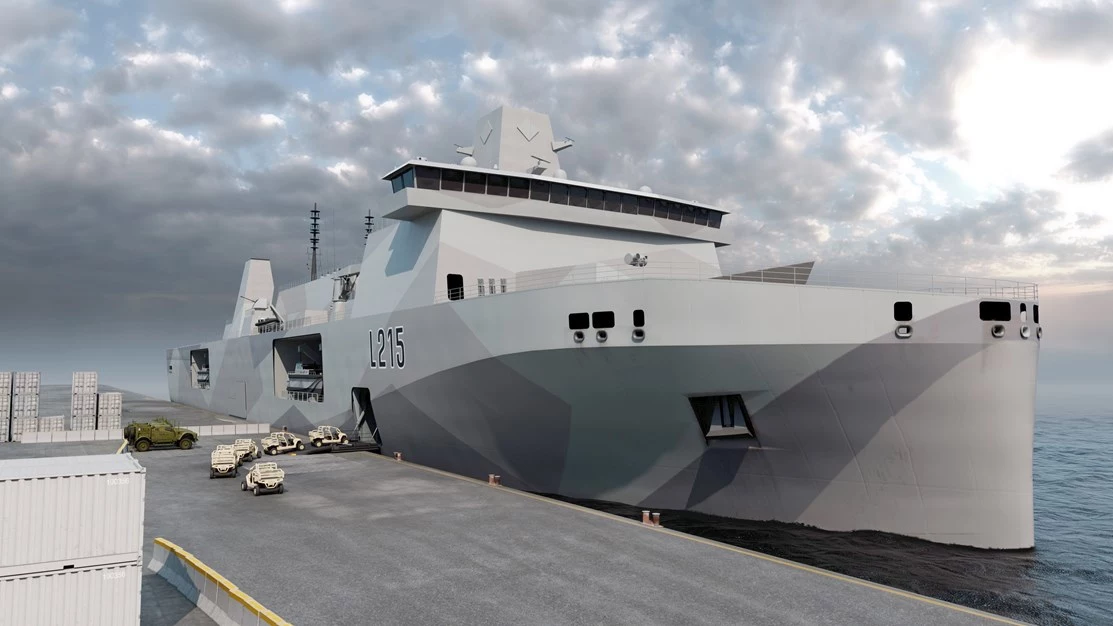What will the Royal Navy's amphibious strike force of the future look like? Design consultancy BMT Group has its own answer as it unveils Ellida Strike concept multi-role strike vessel designed to put combat troops ashore without port facilities.
One of the rarest and most difficult capabilities of any nation to attain is force projection. That is, the independent capability of sending a military expeditionary force anywhere in the world and maintaining it there indefinitely. Currently, only the United States and Britain arguably have this capability, though the latter may lack this for the next eight years.
It's not a matter of overall military strength, but having the right mixture of equipment and logistical support. This projection is dependent in large part on the ability to land troops, often on hostile shores. That requires amphibious assault ships that can carry helicopters, drones, troops, vehicles, and supplies. These long-range ships are notable in that they have the ability to sink into the water to flood their well-deck to deploy and pick up landing craft.
The problem is that the Royal Navy's only two amphibious assault ships, HMS Bulwark and HMS Albion, have been decommissioned years before their planned retirement and have already been sold to Brazil for £20 million (US$27 million).
The decision is controversial, with the government arguing that neither ship is fit for service, would cost far too much to repair, and the upgrade would take them beyond their retirement age anyway. Meanwhile, critics point out that £72 million (US$97 million) has already been spent on a refit and that their replacements, the Multi-Role Support Ships (MRSS), will take until 2033 to come online and might not be fit for purpose.

To address this, BMT recently put forward its concept for what the next generation of assault ships for the Navy could look like and how it will meet the strategic needs of tomorrow.
The Ellida Strike is the latest in BMT's Ellida family of ships and is designed specially to meet the Navy's Multi-Role Strike Ship (MRSS) program requirements. The result is a modular vessel that's flexible and adaptable for a wide range of missions, beyond amphibious combat to include humanitarian aid and disaster relief.
This is due to the use of containerized pods that are like the ones in the old Thunderbirds television series where the superplane Thunderbird 2 was fitted out with specific pods for specific missions. In the case of Ellida Strike, this can include medical support, command and control, logistics, or combat operations.
In addition to its modularity, the Ellida Strike can be equipped with long-range precision missile systems and it has enough surplus power to support directed energy weapons. Because it has a "for but not with" approach to weapon systems, it can be quickly refitted and upgraded. Since this is a 21st-century warship, it has advanced digital systems for network communications and modern command-and-control systems.
Because it's a concept, the Ellida Strike's specifications haven't been released, but if it's similar to previous variants, it will be about 200 m (660 ft) long, displace about 27,800 tonnes, be capable of speeds in excess of 18 knots (21 mph, 33 km/h), and have a range of about 8,500 nautical miles (9,800 miles, 15,700 km). Crew estimates could be 150 personnel with 300 embarked troops.
"Whilst Ellida Strike is not the final answer, it’s a strong foundation for further development," said Tim Neild CBE, Head of Business Development, UK & Europe at BMT. "It invites discussion, collaboration and refinement. As the Royal Navy continues to shape its requirements, we stand ready to adapt and evolve our design to meet the needs of tomorrow’s operations. This concept represents a capability-led approach to design – showcasing what’s possible and demonstrating that BMT has both the expertise and the openness to partner as requirements mature."
Source: BMT





